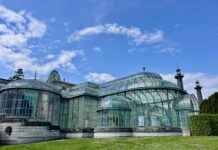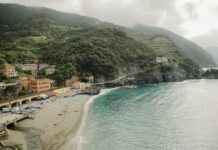On the day when the waves tumbled into his village of Hassanabad, in northern Pakistan, Javed Rahi, a retired mathematics teacher, was to attend the wedding of a nephew.
«I expected women and children to sing and dance (…) Instead, I heard them screaming in fear,» says the almost septuagenarian. «It felt like the end of time.»
In the disaster, which occurred in May, in the middle of a heat wave, nine houses were destroyed and half a dozen damaged.
The surge of water also washed away two micro-hydroelectric power stations and the bridge that linked this isolated village to the rest of the country.
Pakistan has more than 7,000 glaciers, more than any other country on earth outside the polar lands. But with global warming, these are rapidly melting, creating thousands of glacial lakes.
Thirty-three of these lakes, formed in the Himalayan, Hindu Kush or Karakoram ranges, are at high risk of overflowing and spilling millions of cubic meters of water and debris downstream, authorities said.
At least 16 cases of sudden emptying of a glacial lake (Glof, according to the English acronym), caused by rising temperatures, have already been recorded this year, against five or six last year, indicated this week the government.
The damage is usually so extensive that it is difficult for local communities to recover from such disasters.
In Hassanabad, Mr. Rahi and the other residents who lost their homes were moved to a camp near the village. Under their makeshift tents, drag the rare possessions they were able to save and mattresses to sleep on.
«We never thought we would go from rich to ragged,» sighs Mr. Rahi.
Pakistan is particularly vulnerable to climate change. It is in 8th position of the countries most threatened by extreme weather phenomena, according to a study by the NGO Germanwatch.
– Unaware of the threat –
It faces increasingly frequent, anticipated and stifling periods of heat. This year, the temperatures have in places exceeded 50°.
Floods and droughts have killed and displaced thousands of people in recent years, damaging infrastructure and destroying livelihoods.
According to the United Nations Development Program (UNDP), the lack of information on changes in Pakistan’s glacial regions makes it difficult to accurately predict where a disaster could occur.
Although Hassanabad had a warning system, with cameras to monitor the level of glacial lakes, residents were persuaded to live high enough to be safe, according to local officials.
Zahida Sher, who also lost her house that day, explains that the force of the waves swept away buildings that had been considered very solid until then.
Mountain communities depend on livestock, orchards, farms and tourism to survive. But everything is threatened by climate change.
«Our economy is agrarian and people don’t have enough resources to leave here,» said Ms. Sher, a researcher for a local development NGO.
According to Siddique Ullah Baig, a natural hazard management expert, around seven million people are under threat from Glofs in northern Pakistan. But most are unaware of the threat.
«People continue to build houses in places in flood zones. They are not informed and prepared to face a natural disaster,» he told AFP.
A little north of Hassanabad is the hamlet of Passu, which has lost almost 70% of its population and area after being hit by flash floods and due to natural river erosion.
The village is wedged between two glaciers, to the north and south, and the Hunza River to the east. These three natural elements are called «dragons» by the inhabitants, for their power of destruction.
– ‘The mouth of the dragons’ –
«The village of Passu rests in the mouths of these three dragons,» observes Ali Qurban Mughani, a local scholar, pointing to the glacial mass overlooking it.
As he speaks, workers are building a concrete wall on one of the nearby banks, in an attempt to protect the village from erosion.
Kamran Iqbal had invested 500,000 rupees (2,350 euros), a sum borrowed from a local NGO, to open a picnic area for tourists, in a place which enjoys a breathtaking view.
The beauty of the glaciers has made this region one of the most touristic in the country.
His business was going well, until this «night of horror» last year, when a flood took everything away.
Even if the most ambitious international objectives of limiting the rise in temperature linked to global warming to 1.5° by the end of the century are respected, almost a third of Pakistan’s glaciers could have melted by then, indicated the International Center for Integrated Mountain Development (Icimod), based in Nepal, in a study published in 2019.
«In 2040, we may begin to face problems of (water) scarcity, which could lead to drought and desertification. And before that, we may face intense and frequent flooding along rivers, and of course flash floods,» said Aisha Khan, head of Pakistan’s Mountains and Glaciers Protection Organization.
Pakistan, home to a population of 220 million, says it is responsible for less than 1% of global greenhouse gas emissions.
Despite this, it is particularly threatened by climate change, because it is very dependent on its agriculture and its natural resources, sectors that are very sensitive to climate change.
«We don’t have any factories or industries here that can cause pollution… Our environment is clean,» said 60-year-old Amanullah Khan, one of the village elders of Hassanabad.
«But when it comes to the threat posed by climate change, we are on the front line,» he said.
Asif Sakhi, a local political activist, remarks that people in the area are increasingly fearful of the threat posed by glaciers, and laments: «This area belongs to the glaciers; we have occupied it.»














